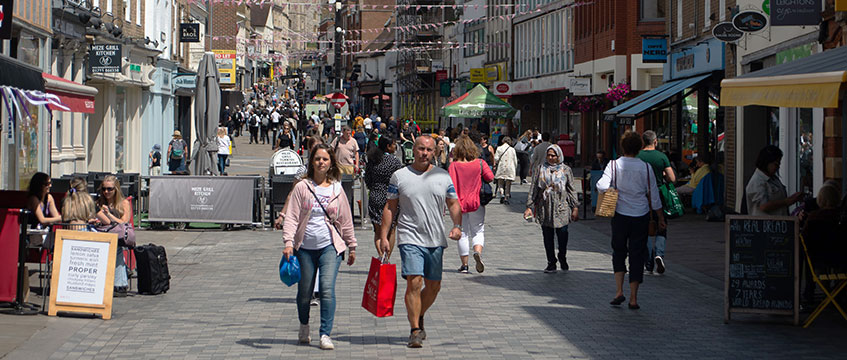The idea behind “15-minute cities” is that residents live within a 15-minute walk, bike ride or public transit point from all basic services, such as work, shopping, schools, healthcare and community and leisure facilities. One of the main goals is to reduce traffic and emissions which are contributing to global warming. However, benefits also include social cohesion and inclusion and creating active, commercial communities.
Where did they come from?
The idea of neighbourhoods where essential services are within walking distance dates back to the early 1960s. However, the specific concept of 15-minute cities was developed by Carlos Morena, an urban planner and professor, in 2010. The concept – and similar concepts like the 20-minute neighbourhood – have been incorporated by cities such as Canterbury, Birmingham, Ipswich, Oxford and Leeds.
Why are they controversial?
At the recently concluded Conservative Party conference, transport secretary Mark Harper said he was “calling time” on the misuse of 15-minute cities and that it was sinister and intolerable that “local councils can decide how often you go to the shops and that they ration who uses the roads and when, and they police it all with CCTV”. The government publication, Plan for Drivers (October 2023) states that the government intends “to stop local authorities using so-called ‘15-minute cities’ to police people’s lives”, including consulting on measures such as the removal of local authorities’ access to DVLA data to enforce such schemes by camera.
Oxford City Council’s plans to restrict the use of certain routes by private cars have been erroneously linked to 15-minute cities and may explain the above references to cameras and DVLA records. The plans resulted in a protest and worldwide media condemnation, with councillors and officers receiving abuse from the public and anxious questions from citizens, worried about losing personal freedoms. Reactions like this have been repeated in cities around the world and, of course, on social media and the internet.
Leaving aside a detailed review of the various conspiracy theories, the fear seems to be that people will be forced to stay within the 15-minute confines, whether to combat climate change or for other more sinister reasons, rather than developers being encouraged to design 15-minute cities.
Sustainability and 15-minute cities
The idea of 15-minute cities has its roots in sustainability. Sustainable development encompasses the environmental, economic and social aspects of development. A reference to sustainable development in planning usually includes encouraging developments to be close to essential facilities to reduce the need to travel by private car.
Planning decisions are made in accordance with local plans and material planning considerations. The National Planning Policy Framework requires councils to put sustainability at the heart of their local plans, which they do, and demonstrates that sustainability is an important material planning consideration.
To illustrate, the NPPF states:
“93. Planning policies and decisions should aim to achieve healthy, inclusive and safe places which:
c) enable and support healthy lifestyles, especially where this would address identified local health and wellbeing needs – for example through the provision of safe and accessible green infrastructure, sports facilities, local shops, access to healthier food, allotments and layouts that encourage walking and cycling.
105. Significant development should be focused on locations which are or can be made sustainable, through limiting the need to travel and offering a genuine choice of transport modes. This can help to reduce congestion and emissions and improve air quality and public health. However, opportunities to maximise sustainable transport solutions will vary between urban and rural areas, and this should be taken into account in both plan-making and decision-making.
106. Planning policies should:
a) Support an appropriate mix of uses across an area, and within larger-scale sites, to minimise the number and length of journeys needed for employment, shopping, leisure, education and other activities.”
National planning policy predating the NPPF also stated that the general approach to delivering sustainable development included to: “Provide improved access for all to jobs, health, education, shops, leisure and community facilities, open space, sport and recreation, by ensuring that new development is located where everyone can access services or facilities on foot, bicycle or public transport rather than having to rely on access by car, while recognising that this may be more difficult in rural areas.”
The above approach is also reflected in various local plan policies.
What is new?
The idea of having facilities close to residents to reduce travel, emissions and create social cohesion is not new. However, the impact of incorporating 15-minute cities into local plans may depend on how these policies are framed.
Policies can make it desirable to create 15-minute cities and give, in essence, extra planning points for doing so, or they can decide that 15-minute cities must be created, whether in certain locations or in terms of a proportion of development.
Although it is hard to see any objections to a 15-minute city model which does not impinge on freedom of movement, it may have an impact on those trying to create developments, who must deal with issues like poor public transport or cycle or pedestrian links and routes in certain parts of the country.
Also, the unexpected response to the idea of 15-minute cities underscores the importance of public buy-in. Public consultation is important. However absurd these conspiracy theories may seem, it is still necessary to engage with the public and combating those misconceptions is a task that must be carefully undertaken.
Tracy Lovejoy is a senior associate in the planning and environment team at Irwin Mitchell








